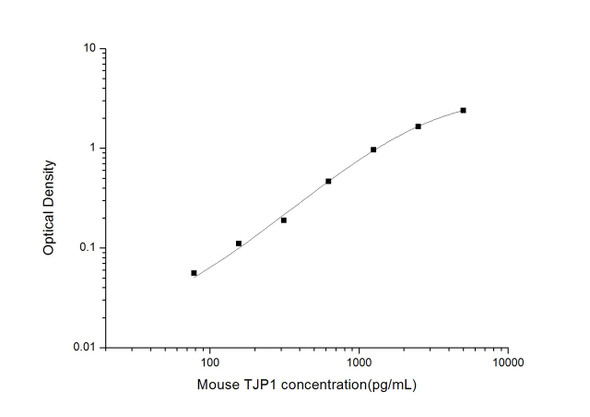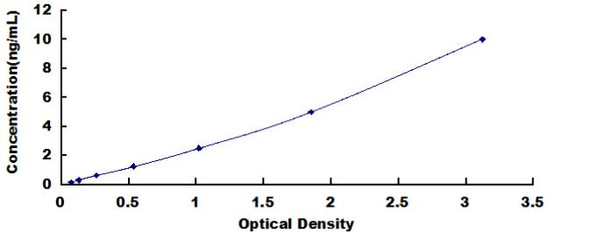Description
Mouse Zona Occludens 1/Tight Junction Protein 1 ELISA Kit
The Mouse Zona Occludens-1 (Tight Junction Protein-1) ELISA Kit is a comprehensive tool for precise detection of Zona Occludens-1 levels in mouse serum, plasma, and cell culture supernatants. This kit offers exceptional sensitivity and specificity, ensuring accurate and consistent results, making it ideal for a wide range of scientific investigations.Zona Occludens-1 is a critical protein involved in the formation of tight junctions, essential for maintaining the integrity of epithelial and endothelial barriers. Dysregulation of Zona Occludens-1 has been linked to various diseases, including inflammatory bowel disease, autoimmune disorders, and cancer.
Therefore, this ELISA kit is a valuable asset for researchers studying these conditions and exploring potential therapeutic interventions.In conclusion, the Mouse Zona Occludens-1 (Tight Junction Protein-1) ELISA Kit provides a robust and reliable platform for quantifying Zona Occludens-1 levels, facilitating in-depth research and discovery in the field of molecular biology and biomedical sciences.
| Product Name: | Mouse Zona Occludens 1 / Tight Junction Protein 1 ELISA Kit |
| Product Code: | MOFI01155 |
| Size: | 96 Assays |
| Alias: | TJP1 |
| Detection Method: | Sandwich ELISA |
| Application: | This immunoassay kit allows for the in vitro quantitative determination of Mouse TJP1 concentrations in serum plasma and other biological fluids. |
| Sensitivity: | 46.875pg/ml |
| Range: | 78.125-5000pg/ml |
| Storage: | 4°C for 6 months |
| Note: | For Research Use Only |
| Recovery: | Matrices listed below were spiked with certain level of Mouse TJP1 and the recovery rates were calculated by comparing the measured value to the expected amount of Mouse TJP1 in samples. | ||||||||||||||||
| |||||||||||||||||
| Linearity: | The linearity of the kit was assayed by testing samples spiked with appropriate concentration of Mouse TJP1 and their serial dilutions. The results were demonstrated by the percentage of calculated concentration to the expected. | ||||||||||||||||
| |||||||||||||||||
| Intra Assay: | CV <8% | ||||||||||||||||
| Inter Assay: | CV <10% |
| Component | Quantity | Storage |
| ELISA Microplate (Dismountable) | 8×12 strips | 4°C for 6 months |
| Lyophilized Standard | 2 | 4°C/-20°C |
| Sample/Standard Dilution Buffer | 20ml | 4°C |
| Biotin-labeled Antibody(Concentrated) | 120ul | 4°C (Protect from light) |
| Antibody Dilution Buffer | 10ml | 4°C |
| HRP-Streptavidin Conjugate(SABC) | 120ul | 4°C (Protect from light) |
| SABC Dilution Buffer | 10ml | 4°C |
| TMB Substrate | 10ml | 4°C (Protect from light) |
| Stop Solution | 10ml | 4°C |
| Wash Buffer(25X) | 30ml | 4°C |
| Plate Sealer | 5 | - |
Other materials and equipment required:
- Microplate reader with 450 nm wavelength filter
- Multichannel Pipette, Pipette, microcentrifuge tubes and disposable pipette tips
- Incubator
- Deionized or distilled water
- Absorbent paper
- Buffer resevoir
| Uniprot | P39447 |
| UniProt Protein Function: | Function: The N-terminal may be involved in transducing a signal required for tight junction assembly, while the C-terminal may have specific properties of tight junctions. The alpha domain might be involved in stabilizing junctions. Plays a role in the regulation of cell migration by targeting CDC42BPB to the leading edge of migrating cells |
| UniProt Protein Details: | By similarity. Subunit structure: Homodimer, and heterodimer with TJP2/ZO-2 and TJP3/ZO-3. Interacts with CGN/cingulin, CALM, CXADR, GJD3, HSPA4 and UBN1. Interacts (via ZU5 domain) with CDC42BPB. Interacts (via PDZ domain) with GJA1 By similarity. Interacts with OCLN, claudins, GJA12 and KIRREL1. Interacts with BVES (via the C-terminus cytoplasmic tail). Interacts (via ZU5 domain) with MYZAP. Interacts (via PDZ domains) with ANKRD2 By similarity. Ref.3 Ref.4 Ref.5 Ref.12 Subcellular location: Cell membrane; Peripheral membrane protein; Cytoplasmic side By similarity. Cell junction tight junction By similarity. Cell junction gap junction. Cytoplasm myofibril sarcomere I band. Note: Moves from the cytoplasm to the cell membrane concurrently with cell-cell contact. Detected at the leading edge of migrating and wounded cells By similarity. Ref.12 Domain: The second PDZ domain mediates interaction with GJA12. Ref.4 Post-translational modification: Phosphorylated. Dephosphorylated by PTPRJ By similarity. Sequence similarities: Belongs to the MAGUK family.Contains 1 guanylate kinase-like domain.Contains 3 PDZ (DHR) domains.Contains 1 SH3 domain.Contains 1 ZU5 domain. |
| UniProt Code: | P39447 |
| NCBI GenInfo Identifier: | 303710 |
| NCBI Gene ID: | 21872 |
| NCBI Accession: | BAA03274.1 |
| UniProt Secondary Accession: | P39447,E9QK00, |
| UniProt Related Accession: | P39447 |
| Molecular Weight: | |
| NCBI Full Name: | ZO-1 |
| NCBI Synonym Full Names: | tight junction protein 1 |
| NCBI Official Symbol: | Tjp1 |
| NCBI Official Synonym Symbols: | ZO1 |
| NCBI Protein Information: | tight junction protein ZO-1; zona occludens protein 1; zonula occludens protein 1 |
| UniProt Protein Name: | Tight junction protein ZO-1 |
| UniProt Synonym Protein Names: | Tight junction protein 1; Zona occludens protein 1; Zonula occludens protein 1 |
| UniProt Gene Name: | Tjp1 |
| UniProt Entry Name: | ZO1_MOUSE |
*Note: Protocols are specific to each batch/lot. For the correct instructions please follow the protocol included in your kit.
| Step | Procedure |
| 1. | Set standard, test sample and control (zero) wells on the pre-coated plate respectively, and then, record their positions. It is recommended to measure each standard and sample in duplicate. Wash plate 2 times before adding standard, sample and control (zero) wells! |
| 2. | Aliquot 0.1ml standard solutions into the standard wells. |
| 3. | Add 0.1 ml of Sample / Standard dilution buffer into the control (zero) well. |
| 4. | Add 0.1 ml of properly diluted sample (Human serum, plasma, tissue homogenates and other biological fluids.) into test sample wells. |
| 5. | Seal the plate with a cover and incubate at 37 °C for 90 min. |
| 6. | Remove the cover and discard the plate content, clap the plate on the absorbent filter papers or other absorbent material. Do NOT let the wells completely dry at any time. Wash plate X2. |
| 7. | Add 0.1 ml of Biotin- detection antibody working solution into the above wells (standard, test sample & zero wells). Add the solution at the bottom of each well without touching the side wall. |
| 8. | Seal the plate with a cover and incubate at 37°C for 60 min. |
| 9. | Remove the cover, and wash plate 3 times with Wash buffer. Let wash buffer rest in wells for 1 min between each wash. |
| 10. | Add 0.1 ml of SABC working solution into each well, cover the plate and incubate at 37°C for 30 min. |
| 11. | Remove the cover and wash plate 5 times with Wash buffer, and each time let the wash buffer stay in the wells for 1-2 min. |
| 12. | Add 90 µL of TMB substrate into each well, cover the plate and incubate at 37°C in dark within 10-20 min. (Note: This incubation time is for reference use only, the optimal time should be determined by end user.) And the shades of blue can be seen in the first 3-4 wells (with most concentrated standard solutions), the other wells show no obvious color. |
| 13. | Add 50 µL of Stop solution into each well and mix thoroughly. The color changes into yellow immediately. |
| 14. | Read the O.D. absorbance at 450 nm in a microplate reader immediately after adding the stop solution. |
When carrying out an ELISA assay it is important to prepare your samples in order to achieve the best possible results. Below we have a list of procedures for the preparation of samples for different sample types.
| Sample Type | Protocol |
| Serum: | If using serum separator tubes, allow samples to clot for 30 minutes at room temperature. Centrifuge for 10 minutes at 1,000x g. Collect the serum fraction and assay promptly or aliquot and store the samples at -80°C. Avoid multiple freeze-thaw cycles. If serum separator tubes are not being used, allow samples to clot overnight at 2-8°C. Centrifuge for 10 minutes at 1,000x g. Remove serum and assay promptly or aliquot and store the samples at -80°C. Avoid multiple freeze-thaw cycles. |
| Plasma: | Collect plasma using EDTA or heparin as an anticoagulant. Centrifuge samples at 4°C for 15 mins at 1000 × g within 30 mins of collection. Collect the plasma fraction and assay promptly or aliquot and store the samples at -80°C. Avoid multiple freeze-thaw cycles. Note: Over haemolysed samples are not suitable for use with this kit. |
| Urine & Cerebrospinal Fluid: | Collect the urine (mid-stream) in a sterile container, centrifuge for 20 mins at 2000-3000 rpm. Remove supernatant and assay immediately. If any precipitation is detected, repeat the centrifugation step. A similar protocol can be used for cerebrospinal fluid. |
| Cell culture supernatant: | Collect the cell culture media by pipette, followed by centrifugation at 4°C for 20 mins at 1500 rpm. Collect the clear supernatant and assay immediately. |
| Cell lysates: | Solubilize cells in lysis buffer and allow to sit on ice for 30 minutes. Centrifuge tubes at 14,000 x g for 5 minutes to remove insoluble material. Aliquot the supernatant into a new tube and discard the remaining whole cell extract. Quantify total protein concentration using a total protein assay. Assay immediately or aliquot and store at ≤ -20°C. |
| Tissue homogenates: | The preparation of tissue homogenates will vary depending upon tissue type. Rinse tissue with 1X PBS to remove excess blood & homogenize in 20ml of 1X PBS (including protease inhibitors) and store overnight at ≤ -20°C. Two freeze-thaw cycles are required to break the cell membranes. To further disrupt the cell membranes you can sonicate the samples. Centrifuge homogenates for 5 mins at 5000xg. Remove the supernatant and assay immediately or aliquot and store at -20°C or -80°C. |
| Tissue lysates: | Rinse tissue with PBS, cut into 1-2 mm pieces, and homogenize with a tissue homogenizer in PBS. Add an equal volume of RIPA buffer containing protease inhibitors and lyse tissues at room temperature for 30 minutes with gentle agitation. Centrifuge to remove debris. Quantify total protein concentration using a total protein assay. Assay immediately or aliquot and store at ≤ -20 °C. |
| Breast Milk: | Collect milk samples and centrifuge at 10,000 x g for 60 min at 4°C. Aliquot the supernatant and assay. For long term use, store samples at -80°C. Minimize freeze/thaw cycles. |






